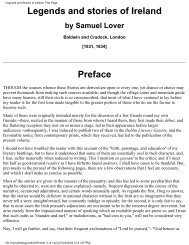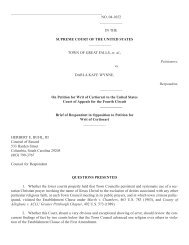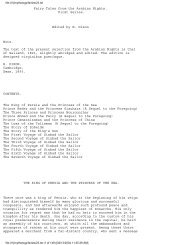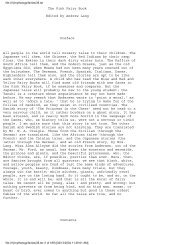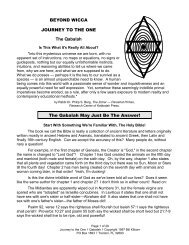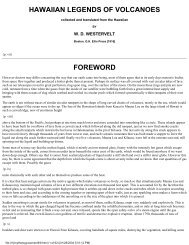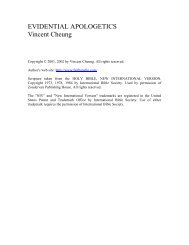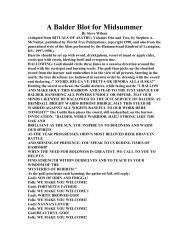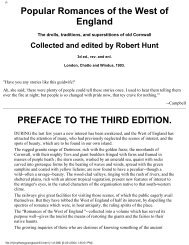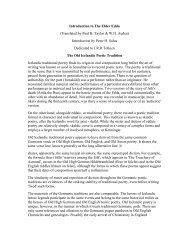You also want an ePaper? Increase the reach of your titles
YUMPU automatically turns print PDFs into web optimized ePapers that Google loves.
depends on the young man's bread, but it is abruptly introduced, suggesting that a part of the story has been forgotten. Both stories,<br />
however, give one the impression that the bread of the fairies was regarded as always imperfectly baked. In both stories the young man's<br />
mother comes to his help with her advice. Mr. Evans' version ascribes supernatural knowledge to the fairy, though his version fails to<br />
support it; and her moralizings read considerably later than those which the Fan legend ascribes to the fairy wife. Some of these points<br />
may be brought under the reader's notice later, when he has been familiarized with more facts illustrative of the belief in fairies.<br />
III.<br />
On returning from South Wales to Carnarvonshire in the summer of 1881, I tried to discover similar legends connected with the lakes of<br />
North Wales, beginning with Geirionydd, the waters of which form a stream emptying itself into the Conwy, near Trefriw, a little below<br />
Llanrwst. I only succeeded, however, in finding an old man of the name of Pierce Williams, about seventy years of age, who was very<br />
anxious to talk about 'Bony's' wars, but not about lake ladies. I was obliged, in trying to make him understand what I wanted, to use the<br />
word morforwyn, that is to say in English, 'mermaid'; he then told me, that in his younger days he had heard people say that somebody had<br />
seen such beings in the Trefriw river. But as my questions were leading ones, his evidence is not worth much; however, I feel pretty sure<br />
that one who knew the neighbourhood of Geirionydd better would be able to find some fragments of interesting legends still existing in<br />
that wild district.<br />
p. 31<br />
I was more successful at Llanberis, though what found, at first, was not much; but it was genuine, and to the point. This is the substance of<br />
it:--An old woman, called Siân 1 Dafydd, lived at Helfa Fawr, in the dingle called Cwm. Brwynog, along the left side of which you ascend<br />
as you go to the top of Snowdon, from the village of lower Llanberis, or Coed y Ddol, as it is there called. She was a curious old person,<br />
who made nice distinctions between the virtues of the respective waters of the district: thus, no other would do for her to cure her of the<br />
defaid gwylltion 2, or cancerous warts, which she fancied that she had in her mouth, than that of the spring of Tai Bach, near the lake<br />
called Llyn Ffynnon y Gwas, though she seldom found it out, when she was deceived by a servant who cherished a convenient opinion of<br />
his own, that a drop from a nearer spring would do just as well. Old Siân has been dead over thirty-five years, but I have it, on the<br />
testimony of two highly trustworthy brothers, who are of her family, and now between sixty and seventy years of age, that she used to<br />
relate to them how a shepherd, once on a time, saw a fairy maiden (un o'r Tylwyth Teg) on the surface of the tarn called Llyn Du'r Arddu,<br />
and how, from bantering and<br />
p. 32<br />
joking, their acquaintance ripened into courtship, when the father and mother of the lake maiden appeared to give the union their sanction,<br />
and to arrange the marriage settlement. This was to the effect that the husband was never to strike his wife with iron, and that she was to<br />
bring her great wealth with her, consisting of stock of all kinds for his mountain farm. All duly took place, and they lived happily together<br />
until one day, when trying to catch a pony, the husband threw a bridle to his wife, and the iron in that struck her. It was then all over with<br />
him, as the wife hurried away with her property into the lake, so that nothing more was seen or heard of her. Here I may as well explain<br />
that the Llanberis side of the steep, near the top of Snowdon, is called Clogwyn du'r Arddu, or the Black Cliff of the Arddu, at the bottom<br />
of which lies the tarn alluded to as the Black Lake of the Arddu, and near it stands a huge boulder, called Maen du'r Arddu, all of which<br />
names are curious, as involving the word du, black. Arddu itself has much the same meaning, and refers to the whole precipitous side of<br />
the summit with its dark shadows, and there is a similar Arddu near Nanmor on the Merionethshire side of Beddgelert.<br />
One of the brothers, I ought to have said, doubts that the lake here mentioned was the one in old Siân's tale; but he has forgotten which it<br />
was of the many in the neighbourhood. Both, however, remembered another short story about fairies, which they had heard another old<br />
woman relate, namely, Mari Domos Siôn, who died some thirty years ago: it was merely to the effect that a shepherd had once lost his<br />
way in the mist on the mountain on the land of Caeau Gwynion, towards Cwellyn 1 Lake, and got into a ring<br />
p. 33<br />
<strong>Title</strong> <strong>Page</strong><br />
where the Tylwyth Teg were dancing: it was only after a very hard struggle that he was able, at length, to get away from them.<br />
To this I may add the testimony of a lady, for whose veracity I can vouch, to the effect that, when she was a child in Cwm Brwynog, from<br />
thirty to forty years ago, she and her brothers and sisters used to be frequently warned by their mother not to go far away from the house<br />
when there happened to be thick mist on the ground, lest they should come across the Tylwyth Teg dancing, and be carried away to their<br />
abode-beneath the lake. They were always, she says, supposed to live in the lakes; and the one here alluded to was Llyn Dwythwch, which<br />
is one of those famous for its torgochiaid or chars. The mother is still living; but she seems to have long since, like others, lost her belief<br />
in the fairies.<br />
After writing the above, I heard that a brother to the foregoing brothers, namely, Mr. Thomas Davies, of Mur Mawr, Llanberis,<br />
remembered a similar tale. Mr. Davies is now sixty-four, and the persons from whom he heard the tale were the same Siân Dafydd of<br />
Helfa Fawr, and Mari Domos Siôn of Tyn 1 Gadlas, Llanberis: the two women were about seventy years of age when he as a child heard it<br />
from them. At my request, a friend of mine, Mr. Hugh D. Jones, of Tyn Gadlas, also a member of this family, which is one of the oldest<br />
perhaps in the place, has taken down from Mr. Davies' mouth all he could remember, word for word, as follows:--<br />
file:///I|/mythology/celtic/26/26.html (30 of 237) [01/22/2004 12:42:26 PM]



